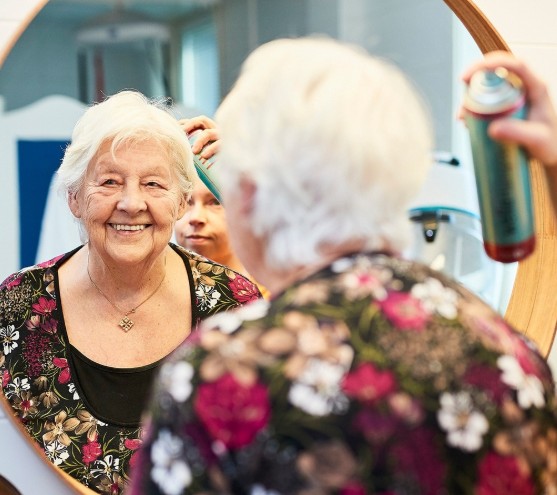Elderly care in Sweden
Sweden’s elderly care system aims to help people live independent lives.
Health and social care for the elderly are important parts of Swedish welfare policy. Of Sweden’s 10.6 million inhabitants, 20 per cent have passed the standard retirement age of 65. This number is projected to rise to 23 per cent by 2040. Here's a brief introduction to elderly care in Sweden.
High life expectancy
Life expectancy in Sweden is among the highest in the world: 82.29 years for men and close to 85.35 years for women. More than 5 per cent of Sweden’s population are aged 80 or older. Since more and more citizens in this age group are in good health, their care requirements have declined since the 1980s.
Largely funded by taxes
Elderly care in Sweden is governed by the Social Services Act (link in Swedish) and is mainly the responsibility of the municipalities. Swedish elderly care is largely funded by municipal taxes and government grants. Healthcare costs paid by the elderly themselves are subsidised.
The right to live together
Sweden’s Social Services Act states that elderly people who have lived together for an extended period can continue to do so even when one of them needs to move into supported accommodation.
Public and private
More municipalities are choosing to privatise parts of their elderly care, letting private care providers run their operations.
All recipients can choose whether they want their home help or special housing to be provided by public or private operators. But for areas such as funding and allocating home help or a place in a special housing facility, the municipality always has overall responsibility.
Accessible housing
Swedish municipalities planning housing and residential areas are required to ensure that they meet the needs of elderly people and those with disabilities. These accessibility requirements have been given greater prominence in legislation over the years.
‘Senior housing’ is ordinary homes for people aged 55 and over – sometimes for over-70s. In such homes, accessibility is a priority. Some are newly built, while others are regular homes that have been made more accessible as part of conversion or renovation work.
Home help makes life easier
One of the aims of elderly care in Sweden is to help elderly people and those with disabilities live independent lives. This includes living in their own homes as long as possible.
Elderly people who continue to live at home can obtain various kinds of support to make life easier. For example, almost all municipalities in Sweden offer ready-cooked meals that can be home-delivered.
Almost half of the country’s municipalities also provide communal meals for the elderly at special day centres, while a few organise small groups of elderly people into teams that cook their own meals.
Individually assessed assitance
When an elderly person is no longer able to cope with the demands of everyday life, he or she can apply for assistance from municipally funded home-help services. The extent of such care is subject to an assessment of need.
Elderly people with disabilities can receive assistance around the clock, which means that many are able to remain at home throughout their lives. The severely ill, too, can be provided with health and social care in their own homes.
How much do individuals pay for elderly care in Sweden?
Each municipality decides its own rates for elderly care. The cost depends on such factors as the level or type of help provided and the person’s income. There is a maximum charge for home help, daytime activities and certain other kinds of care of around SEK 2,642 per month.
Municipalities offer daytime activities for elderly and disabled people in need of stimulation and rehabilitation. These activities primarily target those with dementia or mental disabilities. Daytime activities help many to continue to live in their homes.
Volunteers from organisations such as the Swedish Red Cross (link in Swedish) and many others also visit elderly people living at home or in different kinds of housing. The visits may include a chat, a walk or accompanying someone on a visit to the doctor or hospital.
Transportation services
The elderly and disabled also qualify for transportation services in taxis or specially adapted vehicles. This option is available to those who are unable to travel by regular public transport and it is a service you pay for. Partly tax-funded, these services are significantly cheaper than a regular taxi.
Pensioners associations
- The National Pensioners’ Organisation (PRO, link in Swedish)
- The Swedish Pensioners’ Association (SPF)
- The Swedish Municipal Pensioners’ Association (SKPF, link in Swedish)
The Swedish pension system
All Swedish citizens are entitled to a national retirement pension after they retire. People can choose to start receiving their pension from the age of 63. People also have a legal right to work until the age of 69. Sweden's average retirement is currently around 65.
There are several different sources that make up a Swedish pension. People who have worked and lived in Sweden will get a national public pension, administered by the Swedish Pensions Agency (Pensionsmyndigheten). It consists of income pension, premium pension and guarantee pension. The pension level is based on the income on which the person has paid tax.
The average national public pension in July 2025 was SEK 16,400 per month (link in Swedish). In addition to the national public pension, most people employed in Sweden also get an occupational pension, based on contributions made by their employers.
In January 2025 , 2.3 million people were receiving national public pension.
For added security, many pensioners have chosen to supplement their retirement benefits with private pension savings.
Preparations for an ageing population
Like many other countries, Sweden has a growing proportion of elderly people. Elderly care has therefore become increasingly important, and the government has taken steps to meet future challenges in this area.
In 2040, nearly one in four Swedes will be 65 years or older, and most of the people in this age group will be active and healthy. Several initiatives aimed at meeting future needs are now being put in place around the country. It seems clear, that to meet the coming demographic challenge without jeopardising welfare levels, people will have to work longer.
Preventive care keeps older people healthier
Several new forms of effective preventive healthcare for the elderly have been introduced into elderly care in Sweden in recent years.
One example is physical activity on prescription, both for preventive purposes and as a form of treatment. Older people are prescribed not just exercise in general but a certain type of physical activity, sometimes in combination with medication, with doctors monitoring the results.
Personal injury is one of the main health problems among older people, so considerable efforts are made to reduce injuries from falls. Information is made available to the elderly, and special municipal ‘fixers’ help with things like curtain-hanging and changing light bulbs in the home.
Stimulation through music, films, reading, painting and other cultural activities also plays a role in well-being. This is increasingly recognised in elderly care homes where many people engage in at least one such activity every day.

